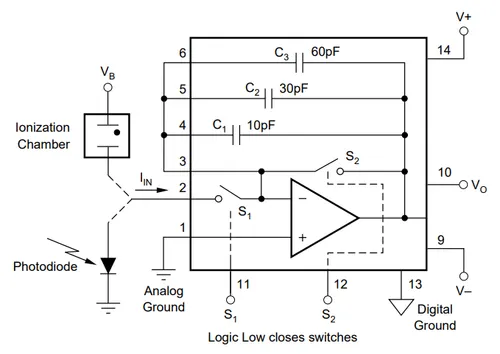Switched Integrator ICs
Switched integrator ICs are integrated circuits (ICs) that are designed to convert very small currents into larger voltages by the process of integration. The integration occurs by feeding the input current into a capacitor for a known time period.
A switched integrator IC is an alternative to using a transimpedance amplifier for measuring the current through a photodiode. However, they are far less common than a standard transimpedance amplifier. This could be due to their extra complexity, cost and reduced bandwidth, with marginal gains in SNR at low frequencies2.
A switched integrator IC usually consists of an op-amp, input connection and output discharging switches (realized with MOSFETs) and a precise small capacitor (in the range of 10-100pF).
Examples
IVC102
The IVC102 is a “precision switched integrator transimpedance amplifier” by Burr Brown (now Texas Instruments)1.
ACF2101
The ACF2101 is a “low noise, dual switched integrator” by Burr Brown (now Texas Instruments). It has two independent channels for converting a small input current into a larger output voltage3.
Footnotes
-
Burr-Brown (now Texas Instruments). IVC102: Precision Switched Integrator Transimpedance Amplifier (datasheet). Retrieved 2022-09-27, from https://www.ti.com/lit/ds/symlink/ivc102.pdf. ↩ ↩2
-
Bonnie C. Baker. Application Bulletin: Comparison of Noise Performance Between a FET Transimpedance Amplifier and a Switched Integrator. Burr-Brown (now Texas Instruments). Retrieved 2022-09-27, from https://www.ti.com/lit/an/sboa034/sboa034.pdf. ↩
-
Burr-Brown (now Texas Instruments). ACF2101: Low Noise, Dual Switched Integrator (datasheet). Retrieved 2022-09-27, from https://www.ti.com/lit/ds/symlink/acf2101.pdf. ↩


